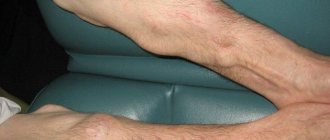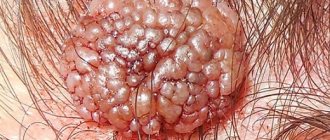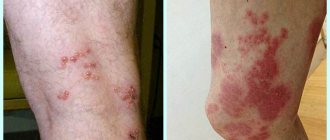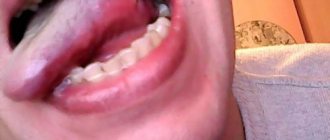- HHV-6A, HHV-6B and diseases associated with them
- How is it transmitted?
- Symptoms and manifestations in children and adults
- What tests to take for diagnosis and what the results mean (IgM, IgG)
- Treatment of children
- Treatment in adults
- Recommendations for pregnant women
Currently, the attention of doctors of all specialties is attracted to diseases caused by representatives of the huge family of herpes viruses. The relevance of herpesvirus infections is due to their so-called “universality” and the ability to lead to the development of acute and chronic diseases of various organs and systems.
The thing is that the human herpes virus ( Human Herpes Virus ) can cause a much more serious disease than most people think.
It can cause the development of many diseases, including severe damage to the central nervous system, liver, gastrointestinal tract, lungs and bone marrow. Herpes also leads to premature birth in pregnant women, interferes with the proper development of newborns and can even lead to disability of the child. Viruses of the Herpes viridae family are able to escape the influence of immune defense, which allows them to exist in the body for a long time. Find out five facts about the herpes virus
General information about the virus
Some people call this strain of herpes “herpes simplex virus type 6,” but this is incorrect. The herpes simplex virus has two types - the first and the second. But herpes virus type 6 behaves a little differently in the body. The immune system, which suppresses the action of herpes virus cells type six throughout the life of the carrier, takes this strain more seriously than the herpes simplex virus. Therefore, with minor disruptions in the body’s immune system, a person is more likely to encounter problems with relapses of HSV than with the sixth type of herpesvirus.
Herpes virus type 6 can masquerade as other diseases, so the clinical picture of the symptoms of this strain is very blurred. When diagnosed, it is often determined by the presence of antibodies to herpes type 7 in the blood due to the fact that they are very related and often work together.
Human herpes virus type 6 has 2 types:
- HHV-6A - in theory affects the development of multiple sclerosis.
- HHV-6B - plays a role in provoking roseola of childhood and immunosuppressive diseases.
American scientists discovered this strain back in 1986; two years later they found a connection between the virus and childhood roseola. Then in 2012, the virus was divided into two types. It was revealed that herpes virus type 6 in adults affects diseases of the nervous system - this is HHV-6A. And in children, HHV-6B causes roseola, it is widespread and most people associate HHV type 6 with this disease.
Clinical picture
When a viral particle enters the human body, herpes type 6 can behave differently. Moreover, the clinical outcome depends almost entirely on the immune system.
Most often, the herpes virus 6 penetrates internally during childhood, the main period of infection is 7-14 months (up to 90% of cases). This situation is more mild, since maternal antibodies still protect the baby and suppress the manifestations of the disease.
The so-called pseudorubella or roseola occurs. There are rashes all over the body. They rise above the skin and are brighter in color in contrast to normal skin color. And they don’t bother the child at all with their itching.
A few days before the appearance of the rash, the body temperature always rises to febrile levels. At the same time, high long-term fever (4-5 days) does not give a person a strong intoxication syndrome.
The patient these days feels relatively healthy and leads an active lifestyle. The fever disappears on its own after a few days. And the most common way to end it is one-time rashes all over the body.
At the same time, the change in clinical manifestations strikingly borders on the physical and emotional state. The appearance of roseola rashes is accompanied by a deterioration in general well-being.
There is a headache, a feeling of weakness, fatigue, and lack of appetite. On the mental side, the patient becomes irritable and overly emotional. You can often detect inflammation of the lymph nodes of various regional groups.
The clinical picture is very similar to the course of rubella, pseudotuberculosis, measles, and erythema infectiosum.
After a few days, all symptoms disappear without a trace. Some people from the clinic listed may only develop an increase in body temperature. The clinical picture with rashes simply falls out of the cycle. This course is often confused with enteroviral diseases.
The infection can be masked behind the following diseases of a systemic and local nature: meningitis, otitis media, sepsis, drug allergies in the form of erythema, erythema infectiosum, bacterial pneumonia.
These symptoms are sure to recur. But the period of chronicity and latency depends on the body’s immune forces and the ability to stop the multiplication of the virus in cells. When the body is weakened, viral particles replicate and characteristic symptoms occur.
But the patient cannot always fight this on his own. And some cases of diseases, failures in the defense of the immune system can lead to more serious manifestations:
- pneumonia of viral and bacterial origin - the virus distracts the immune system, so other viral and bacterial agents freely penetrate the lower respiratory tract, multiplying in the cells of the macroorganism;
- fulminant hepatitis is the most dangerous form of the disease, since typical treatment for hepatitis only accelerates the destructive processes. In this case, the liver decreases in size, symptoms of liver failure progressively increase, and the disease often ends in death;
- myocarditis - occurs as a result of suppression of the immune system and the formation of immune factors in response to the persistence of type 6 herpes virus particles;
- meningitis is one of the masks of the disease, the etiological factor of development is usually another pathogenic microorganism;
- encephalitis - herpes 6 can cause the disease either independently or be a “helper” for another viral or bacterial agent;
- thrombocytopenic purpura of unknown origin - with a strong immunosuppressive effect, platelet growth in the bone marrow is suppressed with further thrombocytopenia (lack of platelets);
- mononucleosis-like syndrome - occurs due to the similarity in the structural structure of types 6 and 4 of herpes, while a typical clinical picture of the disease develops. But it does not have the complications characteristic of persistence of the Epstein-Barr virus in the blood.
That is, type 6 herpes virus in serious diseases is basically just a companion to other etiological links. And symptoms of other pathological processes are often incorrectly assigned to HHV 6.
Relapses can take place in the same form. A one-time entry of the virus into the body ensures lifelong persistence in the blood. The latent period and exacerbation differ only in the number of viral particles in the blood.
But a persistent decline in immunity is necessarily accompanied by an exacerbation. Which, in turn, further weakens the host’s body. Now the risk of contracting another infection increases. Therefore, type 6 HHV is a faithful companion to serious diseases.
Sometimes primary rashes after the temperature disappears are confused with an allergic reaction of the body in response to taking antibacterial drugs.
Transmission routes
The herpes virus is one of the most aggressive viruses in terms of its search for a carrier and one of the most tenacious. The virus is transmitted in three ways:
- through saliva - this is the most common penetration of the virus into a new body; usually type 6 herpes is transmitted from mother to child;
- through blood - the virus can be transmitted both through cuts and through blood transfusion from an infected person to a healthy one;
- during childbirth - we are talking about childbirth, and not about transmission through the placenta, infection occurs when the child passes through the birth canal.
Infection with herpesvirus type 6 occurs in 90% of cases in childhood from six months to two years. Until six months of age, the baby, if he has not been infected through the birth canal, has immunoglobulins of class G, transmitted from the maternal immune system. After the formation of its own immune system, the child is susceptible to infection. The older he gets, the lower the risk of infection.
Prevention
Prevention is aimed at increasing the body's protective functions. To minimize the risk of herpes, you must follow the advice of doctors:
- Healthy lifestyle An excellent solution would be to run daily in the fresh air before going to bed. Also, you need to quit all bad habits.
- Diet. Eating a variety of healthy foods not only boosts your immune system, but also improves your mood.
- Avoiding stressful situations.
- Abstain from kissing and sexual contact with infected people.
Author: Potapov Maxim Aleksandrovich, general practitioner
Symptoms and signs of illness caused by the virus
Let's look at type 6 herpes in adults and the symptoms of diseases that it causes in the older age category. We wrote in detail about the course of the virus in a child in the article - herpes type 6 in children.
Infectious mononucleosis, caused not by the Epstein-Barr virus, but by herpes type 6, exhibits the same symptoms as with symptomatic exacerbations of mononucleosis:
- redness of the throat;
- headache;
- temperature increase;
- joint and throat pain;
- enlarged lymph nodes.
When herpesvirus type 6 manifests itself as chronic fatigue syndrome, symptoms may include the following:
- depression;
- constant fatigue;
- in the morning you feel weak and not getting enough sleep;
- manifestation of causeless aggression;
- inability to control oneself;
- temperature changes;
- inflammation of the lymph nodes;
- constant malaise.
Mononucleosis and CFS are the most closely associated diseases with herpes virus type 6 in adults. The remaining diseases will be listed as complications; they have their own symptoms.
In adults
In adults, the disease occurs without a rash. It can be easily confused with enterovirus infection. Manifestations of herpes type 6 can masquerade as other dangerous pathologies:
- rubella;
- measles;
- meningococcal infection;
- inflammation of the middle and inner ear;
- pneumonia;
- erythema.
When reactivated, herpes type 6 can cause severe damage to the central nervous system.
Often the disease occurs due to a lack of vitamins and microelements. Some studies indicate that in women, herpesvirus infection can cause intrauterine death of the child and premature birth.
Diagnostics
Testing for herpes type 6 is most often carried out using two methods:
- PCR (polymerase chain reaction) - detects viral DNA;
- ELISA (enzyme-linked immunosorbent assay) is a very accurate method that will detect DNA and indicate a primary infection or a recurrent form.
Diagnosis for herpes virus type 6 is not always necessary, even when symptoms are present. Typically, confirmation by laboratory methods is necessary in controversial situations when there is uncertainty in the choice of antiviral drugs by the attending physician or if it is impossible to diagnose the causes of enlarged lymph nodes. And also at times when the patient is in serious condition.
If you have already been tested for herpes virus type 6 and want to find out the decoding, there are four results:
- Immunoglobulins of class M and G are negative (IgM -, IgG -) - this indicates that there is no immune response and antibodies to the virus, the patient is at risk of primary infection.
- Immunoglobulins class M are negative, and class G is positive (IgM -, IgG +) - this indicates the presence of immunity to the virus. The risk of relapse depends on the state of the immune system.
- Immunoglobulins of class M are positive, and class G is negative (IgM+, IgG -) - this means that the patient has a primary infection. It is urgent to start treatment.
- Immunoglobulins class M and G are positive (IgM+, IgG+) - Relapse of the disease, but there is an immune response, treatment must be started.
In children, if symptoms of infantile roseola are present, it is also worthwhile to undergo laboratory diagnostics, despite the fact that, perhaps, while the results are ready, the child may already have recovered, it is necessary to confirm the diagnosis. Roseola infantum can be confused with many diseases and if it is not roseola infantile, tests will be very helpful.
Preventive actions
To summarize, we can say that the main goal when a pathogen is detected in the body is to prevent its activation. To do this, certain rules must be followed:
- strengthen the body by hardening;
- adhere to a daily routine, sleep at least 7 hours a day;
- lead an active lifestyle, play sports in the absence of contraindications;
- adhere to a proper diet, consume a large amount of seasonal vegetables and fruits, remove fatty foods from your menu;
- eliminate bad habits, do not smoke and minimize the consumption of alcoholic beverages;
- Do not take medications on your own, especially antibiotics.
When the first signs of illness appear (during primary infection or during an exacerbation), you must seek medical help. It is impossible to independently recognize type 6 herpes infection, and infection is inevitable for every person, since even in the latent stage the infection is released from the body with saliva.
Treatment
If there are no complications yet and it is necessary to suppress the virus in the body, an integrated approach is used to treat type 6 herpes, aimed at combating symptoms and the virus, as well as stimulating the immune system. There are five groups of drugs for the treatment of herpes virus type 6:
- Antiviral - Foscarnet and Ganciclovir are worth highlighting among the drugs that fight viruses. Acyclovir and its analogues have not shown adequate effectiveness in the treatment of herpesvirus type 6.
- Immunomodulators - to maintain and enhance the body’s defense mechanisms, you should pay attention to drugs such as Viferon, Neovir and Kipferon.
- Vitamin therapy - for additional stimulation of the immune system, vitamin complexes containing vitamins A, E and C are often prescribed.
- Antipyretics are for symptomatic treatment; with an exacerbation of herpes type 6, as we found out above, a high temperature is characteristic and it must be normalized.
- Immunoglobulins - from this group of drugs, Lykopid, Amiksin and Gerpimun 6 are often prescribed against type 6 herpesvirus.
Do not forget that the prescription of a combination of medications should be entrusted only to your doctor. During pregnancy, you should take this even more seriously, since most of the drugs described above are not recommended for women to take while pregnant.
Treatment of herpes type 6 in children
It’s probably no secret that choosing medications for a child that will help get rid of the disease without causing harm is much more difficult than for adults. Many medications cannot be used on newborns and children under one year of age, which creates a huge problem for both parents and doctors. But there are still drugs that can be used to combat type 6 herpes even in newborn babies. One of these drugs is the drug VIFERON Suppositories (suppositories), which contains human recombinant interferon alpha-2b. The course of treatment is five days, VIFERON Suppositories 150,000 ME are used once every 12 hours.
If necessary, the doctor can choose a different dosage for the child. Find out more about the safety of VIFERON drugs.
The drug has undergone a full cycle of clinical trials in a wide range of pathologies in leading clinics in Russia. The result of the studies was evidence of the therapeutic, prophylactic and immunocorrective effectiveness of the drug VIFERON for various infectious and inflammatory diseases in adults and children. It has been scientifically proven that the release form provides the drug with unique pharmacodynamic characteristics, and the presence of highly active antioxidants, vitamins E and C, makes it possible to enhance the antiviral activity of interferon. It is also impossible not to note the absence of side effects inherent in parenteral preparations of recombinant interferons (administered by injection). Due to the imperfect functioning of the interferon system at an early age, newborns and children of the first years of life show increased sensitivity to infectious diseases, with a tendency to their more severe and generalized course with a high risk of complications and the development of chronic foci of infection. Timely use of an antiviral drug can help avoid complications and severe disease.
Scheme for using the drug VIFERON Gel and Ointment for children
The antiviral drug VIFERON Gel can also be used to treat children of all ages, including newborns. To combat the manifestations of herpes type 6, it is necessary to apply a strip of gel no more than 0.5 cm long to the previously dried affected surface 3-5 times a day for 5-6 days using a spatula or a cotton swab.
VIFERON Ointment is used in children over one year old. To treat type six herpes, apply a thin layer 3-4 times a day to a previously dried affected surface. The combined use of suppositories VIFERON and VIFERON Ointment/Gel allows you to enhance the clinical effects of the therapy.
Complications
All diseases caused by HHV-6 are complications. Even CFS and roseola infantum. But let’s consider the most serious diseases that can develop due to activation or primary infection with HHV-6:
- multiple sclerosis;
- encephalitis;
- myocarditis;
- infantile roseola with severe course;
- autoimmune diseases;
- diseases associated with central nervous system disorders;
- retrobulbar neuritis;
- liver failure;
- pityriasis rosea.
These diseases can occur for other reasons, and it is impossible to say for sure that this is due to type 6 HHV. But scientific medicine has found patterns in the presence of relapse of herpes of this strain with the course of the above diseases. The problem is that perhaps these diseases cause HHV-6 to relapse, and not vice versa.
To summarize, it is worth noting that herpesvirus type six does not always require treatment. It very rarely appears and causes visible problems. Only one of the two varieties of this strain of human herpes virus has shown frequent activity, and this usually manifests itself in the form of infantile roseola.










